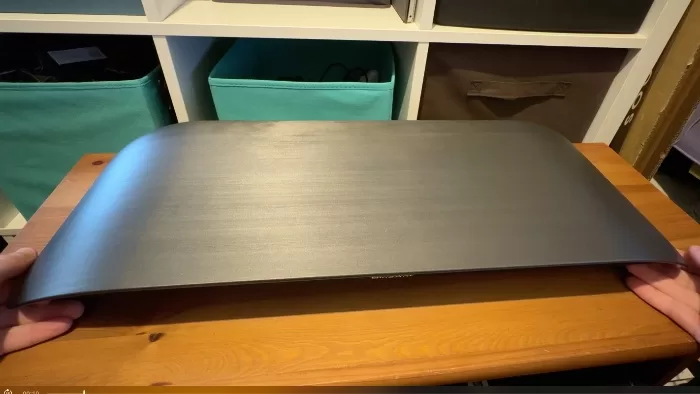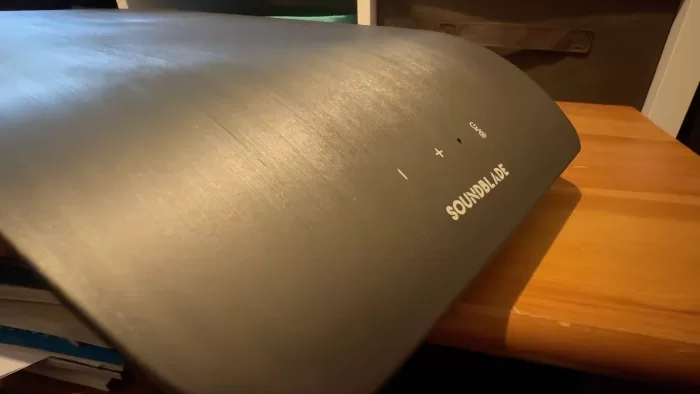BlueAnt’s Soundblade is, effectively, a soundbar for your laptop or desktop PC, delivering very good sound output – though its feet could do with being a little more robust.
| Pros | Cons |
|---|---|
| Good sound output | Rubber extension feet don’t sit all that securely |
| Choice of USB, 3.5mm or Bluetooth connectivity | Not suitable for some very large gaming monitors |
| Remote control makes switching inputs or volume simple | Not all remote functions work if you’re using 3.5mm connections |
Score: 3.6/5
Over the years, I’ve lost track of the number of laptops that have promised me “excellent” sound quality.
While it’s true that the laptops I test today have better speakers and general audio output than those I was testing in, say, 1998 (and you’d expect that), the reality is that the smaller size of a laptop doesn’t really lend itself to true, room-filling audio.
The traditional way to solve for this – or to add better audio (or any audio at all) to a desktop PC was to buy a set of speakers. That works, but it takes up a lot of space on your desk doing so. This is an issue that’s been somewhat solved in the TV world with soundbars, which present a balance between decent audio quality and clutter – or at least the good ones do.
That’s what BlueAnt’s latest speaker, the BlueAnt Soundblade is, essentially. It’s a soundbar, but also a small stand for your computer monitor or laptop to sit on. It’s nicely versatile, the audio quality is decent and, critically better than you’ll get out of any laptop by itself.
Design

The BlueAnt Soundblade measures in at 584 x 218 x 54mm with a curved top designed to house a monitor or laptop above it.
That size would suit nearly every laptop and most monitors, though if you’re a fan of truly huge curved gaming monitors that might not work for you. I tested with a couple of different monitors; one 29 inch LG ultrawide and a 24.5 inch MSI Optix MAG251RX gaming monitor, and both fitted comfortably on top of the BlueAnt Soundblade.
They both did have one slight problem, namely that they were a little lower than I’d ideally like my monitor to be. Sure, the BlueAnt Soundblade, which comes in black, white, blue, green or pink hues looks kinda stylish, but I have to work at my desk all day, and it’s poor ergonomic form to peer downwards at your screen if you can avoid it.

You have lots of colour choices, though I prefer black in this instance. It goes with everything. (Image: BlueAnt)
Turns out the folks at BlueAnt thought of this, because in the box, apart from the BlueAnt Soundblade, you’ll also find a set of 8 extension feet that boost the base upwards.
Which is great in theory.
It’s fairly easy to pop out the standard feet and replace them with the soft rubber extension feet. My only complaint here is that they are, indeed, soft.
That makes them easy to install, and would impact the overall sound quality as solid plastic stands might rattle a little – but it also means that if you do need to push the BlueAnt Soundblade on your desk a little, they pop right off, leaving you with a perilously wobbly stand and monitor. From time to time I need to do this, whether it’s to find a cable, a pen, or just because I need to make a little space on one side or the other of my monitor for other desk items.
It says something that this is my only complaint with the BlueAnt Soundblade’s construction, though. The rest of it is well considered, from the rear inputs – power, 3.5mm audio and USB-C audio – to the remote control that lets you choose inputs, adjust audio equalisation and, naturally enough, volume. It’s not the fanciest remote I’ve ever hit, but it gets the job done, most of the time.
Performance

Why only most of the time? It’s not really the BlueAnt Soundblade’s fault, but there’s an issue if you’re using it with a straight 3.5mm audio connection, as you might if you were (for example) plugging through from a desktop PC, or the headphone output jack on a laptop.
If that’s your wired connection of choice, the remote’s volume and audio equalisation features will work, but not the buttons for track skipping. It’s logical enough as not every 3.5mm connection will include the right signal processing for that kind of activity. Plug in via USB-C or connect via Bluetooth, and the whole remote is yours to use.
One nice feature here if you’re going the USB-C route is that you get both a USB-C to USB-C cable and a USB-C to USB-A cable, making it trivial to connect to just about any computer made after around 1998. Yes, I remember that kind of detail. I’ve been doing this a while, you see.
The BlueAnt Soundblade features 2.1 channel sound with a claimed peak output of 120 watts. The 0.1 there is naturally the subwoofer, an 80mm Neodymium model that fires from the base of the BlueAnt Soundblade. Tip the BlueAnt Soundblade up and your monitor will crash to the ground you can see the subwoofer, if you feel so inclined.
Actual audio output is solid, especially for the kinds of audio that you’re most likely to associate with computer use. Technically, yes, you could connect up most devices that support USB audio, 3.5mm audio or Bluetooth 5.3, but from a practical standpoint, this is absolutely designed to be a PC speaker. The remote provides equaliser presets for music, gaming or movie watching.
As you might expect, game mode focuses a little more on bass to accentuate those shotgun blasts, while movie and music modes take a more balanced approach.
I’ve tended to leave it mostly in music mode for all endeavours, as I found it had the best overall balance and presentation for most content types, but it’s at least nice to have simple choices like that. Naturally there’s nothing at all stopping you doing further equalisations through whatever audio source you’re sending to the BlueAnt Soundblade.
As an upgrade from laptop speakers (or a choice for your desktop) there’s really no doubting that the BlueAnt Soundblade gets the job done rather nicely. If you’re very particular about your sound a full rig of separated speakers would no doubt give you an even wider soundscape, but at the cost of taking up a lot more real estate on your desk.
BlueAnt Soundblade: Alex’s Verdict

It says something when the primary complaint I have against a product is that the rubber feet could be nicer.
Firstly, it says that, indeed, the rubber feet could do with being a bit nicer, or specifically a bit more robust.
Otherwise, I really don’t have too many complaints about the BlueAnt Soundblade. It very much is a soundbar for your laptop or desktop, with just a little more flexibility thanks to the inclusion of Bluetooth.
I can’t see too many people buying it as their speaker of choice just to pair a phone to it, but it’s always nice to have the possibility.
Was this review useful to you? Support independent media by dropping a dollar or two in the tip jar below!
BlueAnt Soundblade: Pricing and availability
The BlueAnt Soundblade retails in Australia for $299.





